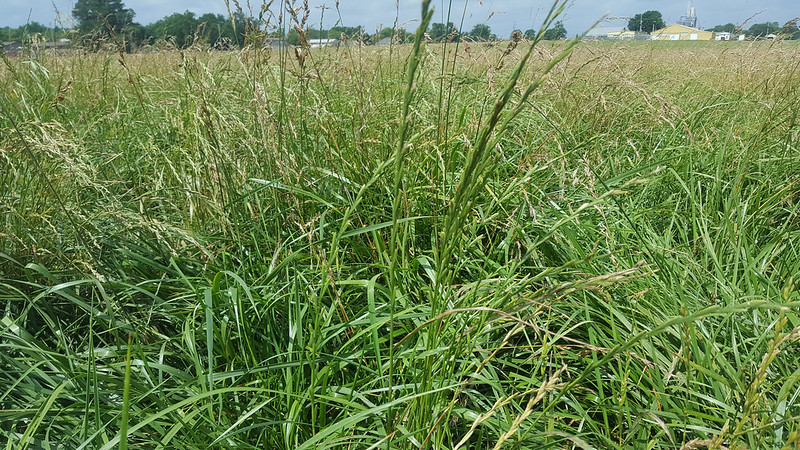Sept. 4, 2020
Now is the time to fertilize fescue
By the U of A System Division of Agriculture
Fast Facts:
- The time to fertilize warm season grasses has passed
- September is the ideal time to fertilize fescue
(527 words)
(Download this story in MS Word format here.)
LITTLE ROCK — While the time to fertilize warm-season grasses may be past, Arkansas ranchers and pasture managers now find themselves in the sweet spot for fertilizing fescue.
John Jennings, extension forage specialist for the University of Arkansas System Division of Agriculture, said that with the exceptional amount of rain that Arkansas and the surrounding region has received recently, he and many Cooperative Extension Service agents have received calls and emails regarding the practice of fertilizing fields for one last cutting.
“For warm season forages such as bermudagrass and bahiagrass, we are at the end of the season,” Jennings said. “However, the timing for fertilizing fescue is right now.”
The University of Arkansas Fertilizer Recommendations Manual states that warm season forages should not be fertilized after September 1.
“Realistically, on drought-stressed forages, the cutoff date should be earlier than that,” Jennings said. “The reasoning is that even after rain, drought stressed forages make take a week to even show green-up and another week to accumulate any leaf area, leaving only about a week to produce any significant amount of forage before short days and cooler nights in late September start shutting down warm season grass growth.”
When night temperatures drop into the 50s, growth stalls for warm season grasses, he said, “and it could take a few days to restart.”
When night temperatures drop into the 40s, growth stops.
“By that time of year, there are not enough warm hours in a day to restart the engine,” Jennings said.
Arkansas research on stockpiling bermudagrass shows that in the northern portion of the state (to include research stations at Batesville and Fayetteville), delaying nitrogen application from August 1 to September 1 reduced forage dry matter yield from 60-80 percent. The same numbers apply to hay production.
In south Arkansas, that date could be moved from August 1 to August 15. Each day closer to September reduces warm season grass yield potential and viability of making late fertilizer applications uneconomical, Jennings said.
But pasture managers working with fescue fields are currently in a good position to boost their output through timely fertilization.
“Our research on fertilizer timing for fall fescue growth, either for fall pasture or stockpiled winter pasture, showed that early September is the optimum time to apply nitrogen fertilizer,” Jennings said. “Waiting until early to mid-October produced no more dry matter yield than the unfertilized control.”
Urea is a viable fertilizer nitrogen source if ammonium nitrate is not available, he said. Several Arkansas forage research trials show yield differences between those nitrogen sources on warm season grasses to range from 0-15 percent.
“So, if producers need fall forage, fescue fertilization is a good option,” Jennings said. “It’s too late to expect a good response from fertilizing warm-season forages.”
Other options for fall forage include planting oats or brassicas in early September. Delays past mid-September on planting brassicas typically produce no grazeable forage in the fall. Millets such as pearl millet, browntop, and Japanese millet can produce some forage if planted the first week of September. Ryegrass is a poor fall forage producer, Jennings said, but can be mixed with winter or summer annual forages to produce spring grazing.
To learn more about extension programs in Arkansas, contact your local Cooperative Extension Service agent or visit www.uaex.uada.edu. Follow us on Twitter at @UAEX_edu.
About the Division of Agriculture
The University of Arkansas System Division of Agriculture’s mission is to strengthen agriculture, communities, and families by connecting trusted research to the adoption of best practices. Through the Agricultural Experiment Station and the Cooperative Extension Service, the Division of Agriculture conducts research and extension work within the nation’s historic land grant education system.
The Division of Agriculture is one of 20 entities within the University of Arkansas System. It has offices in all 75 counties in Arkansas and faculty on five system campuses.
Pursuant to 7 CFR § 15.3, the University of Arkansas System Division of Agriculture offers all its Extension and Research programs and services (including employment) without regard to race, color, sex, national origin, religion, age, disability, marital or veteran status, genetic information, sexual preference, pregnancy or any other legally protected status, and is an equal opportunity institution.
# # #
Media contact:
Ryan McGeeney
Communications Services
University of Arkansas System Division of Agriculture
Cooperative Extension Service
(501) 671-2120
rmcgeeney@uada.edu
